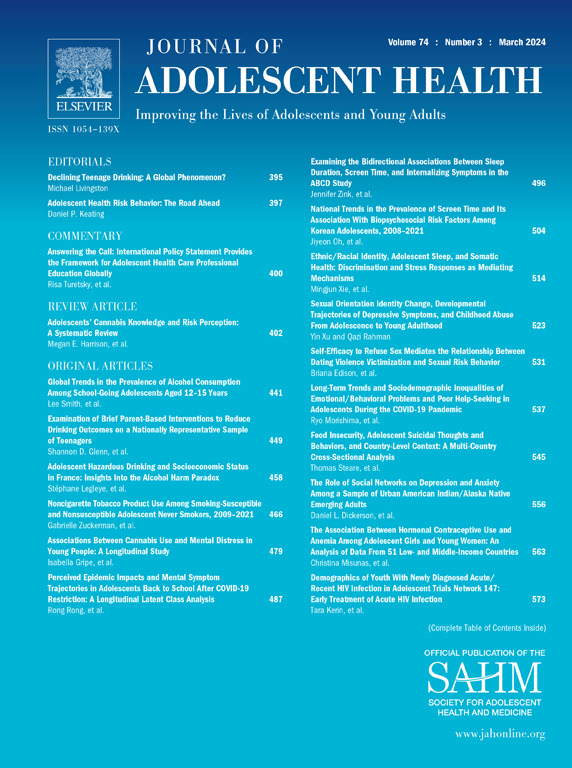睡眠不足对儿童晚期和青少年早期白质发育的影响》(The Impact of Insufficient Sleep on White Matter Development in Late Childhood and Early Adolescence.
IF 5.5
2区 医学
Q1 PEDIATRICS
引用次数: 0
摘要
目的:睡眠对大脑发育至关重要。动物模型表明,睡眠不足会影响轴突和树突(称为神经元)。然而,睡眠不足对人类大脑发育过程中神经元的影响仍未得到充分研究。我们在一个大样本(样本数=1,016;47.44%为女孩)中得出了神经元密度指数和方向分散指数(ODI),旨在确定睡眠不足对童年晚期(平均年龄[标准差]=9.96 [0.62]岁)和青春期早期(平均年龄[标准差]=11.94 [0.64]岁)白质发育的影响:方法:采用纵向潜类分析法,根据儿童睡眠障碍量表的睡眠持续时间得出纵向类别。儿童行为检查表描述了行为问题(内化:焦虑/抑郁、孤僻/抑郁、躯体;外化:社交、思维、注意力、破坏规则和攻击性)。回归分析评估了睡眠等级对神经元密度指数、ODI和标准张量指标(分数各向异性)随时间变化的影响,沿神经束的局灶性或广泛性影响,以及这些影响是否与行为问题相关:确定了睡眠不足(9 小时;N = 447)组。睡眠不足与大多数神经束的纤维连贯性恶化(ODI增大)有关,包括蝶鞍束(F(1,982) = 9.22,P = .002,Q = 0.009)、小镊束(F(1,982) = 5.30,P = .021,Q = 0.026)和上纵筋束(F(1,982) = 7.41,P = .007,Q = 0.015)。这些影响是局灶性的,尤其是在束的额叶部分。其他指标均未受到影响(p > .050)。此外,蝶鞍束中更大的ODI与更多的焦虑/抑郁问题相关(β = 0.10,p = .012,Q = 0.036):我们的研究结果表明,在这一敏感时期睡眠不足会影响白质的发育,进而影响内化问题。我们的研究结果支持在青春期早期促进充足睡眠的重要性。本文章由计算机程序翻译,如有差异,请以英文原文为准。
The Impact of Insufficient Sleep on White Matter Development in Late Childhood and Early Adolescence
Purpose
Sleep is vital for brain development. Animal models have suggested that insufficient sleep affects axons and dendrites (known as neurites). However, the effects of insufficient sleep on neurites during brain development in humans remain understudied. Deriving neurite density index and orientation dispersion index (ODI) in a large sample (N = 1,016; 47.44% girls), we aimed to identify the effects of insufficient sleep on white matter development between late childhood (mean age [standard deviation] = 9.96 [0.62] years) and early adolescence (mean age [standard deviation] = 11.94 [0.64] years).
Methods
Longitudinal Latent Class Analysis was used to derive longitudinal classes based on sleep duration from the Sleep Disturbance Scale for Children. The Child Behavior Checklist characterized behavioral (internalizing: anxious/depressed, withdrawn/depressed, somatic; externalizing: social, thought, attention, rule-breaking, and aggressive) problems. Regression analyses evaluated the effects of sleep classes on neurite density index, ODI, and standard tensor-based metrics (Fractional Anisotropy) changes over time, the focal or widespread effects along the tracts, and whether these effects were associated with behavioral problems.
Results
Insufficient (<9 hours; N = 569) and sufficient sleep (>9 hours; N = 447) groups were identified. Insufficient sleep was associated with worsening fiber coherence (greater ODI) in most tracts, including cingulum bundle (F(1,982) = 9.22, p = .002, Q = 0.009), forceps minor (F(1,982) = 5.30, p = .021, Q = 0.026), and superior longitudinal fasciculus (F(1,982) = 7.41, p = .007, Q = 0.015). These effects were focal, particularly in the frontal portions of the tracts. No other metric was affected (p > .050). In addition, greater ODI in the cingulum bundle was associated with more anxious/depressed problems (β = 0.10, p = .012, Q = 0.036).
Discussion
Our findings suggest that insufficient sleep during this sensitive period affects white matter development, which in turn affects internalizing problems. Our findings support the importance of promoting sufficient sleep during early adolescence.
求助全文
通过发布文献求助,成功后即可免费获取论文全文。
去求助
来源期刊

Journal of Adolescent Health
医学-公共卫生、环境卫生与职业卫生
CiteScore
10.40
自引率
3.90%
发文量
526
审稿时长
46 days
期刊介绍:
The Journal of Adolescent Health is a scientific publication dedicated to enhancing the health and well-being of adolescents and young adults. Our Journal covers a broad range of research topics, spanning from the basic biological and behavioral sciences to public health and policy. We welcome a variety of contributions, including original research papers, concise reports, literature reviews, clinical case reports, opinion pieces, and letters to the editor. We encourage professionals from diverse disciplines such as Anthropology, Education, Ethics, Global Health, Health Services Research, Law, Medicine, Mental and Behavioral Health, Nursing, Nutrition, Psychology, Public Health and Policy, Social Work, Sociology, and Youth Development to share their expertise and contribute to our mission of promoting adolescent health. Moreover, we value the voices of young individuals, family and community members, and healthcare professionals, and encourage them to submit poetry, personal narratives, images, and other creative works that provide unique insights into the experiences of adolescents and young adults. By combining scientific peer-reviewed research with creative expressions, our Journal aims to create a comprehensive understanding of the challenges and opportunities in adolescent and young adult health.
 求助内容:
求助内容: 应助结果提醒方式:
应助结果提醒方式:


